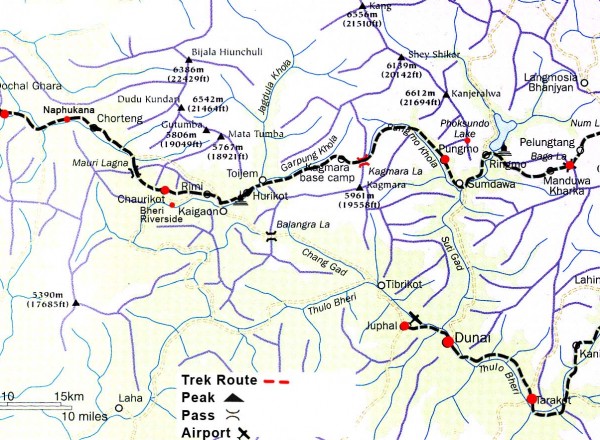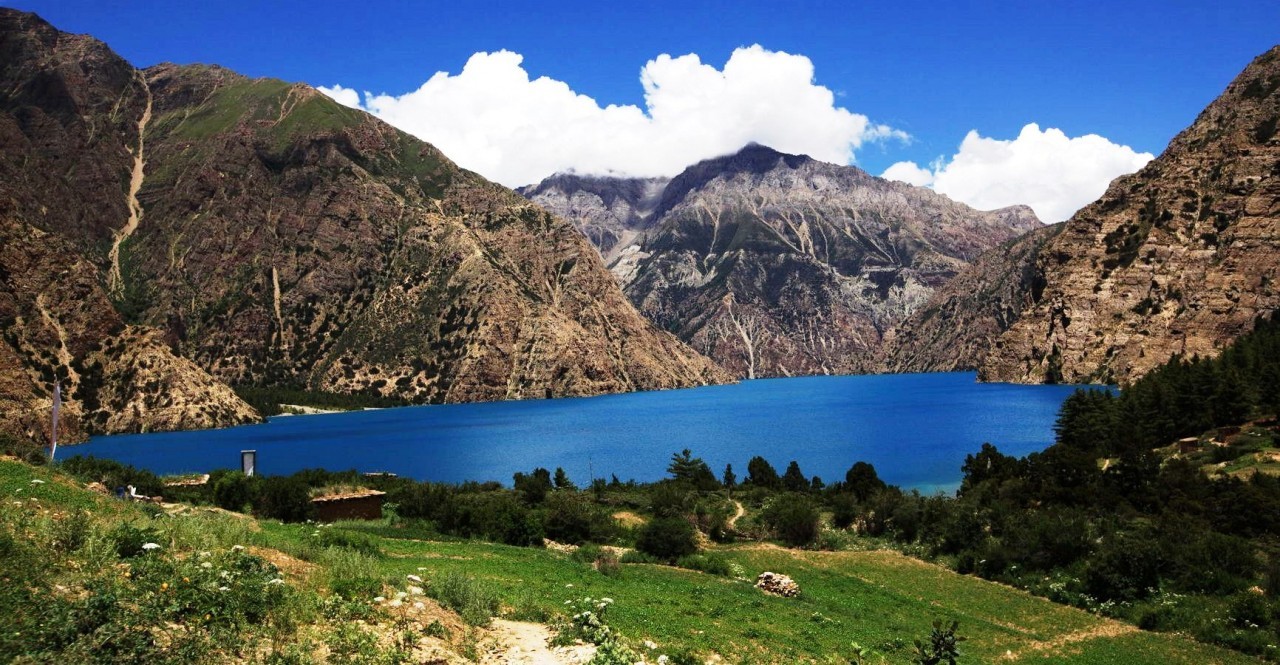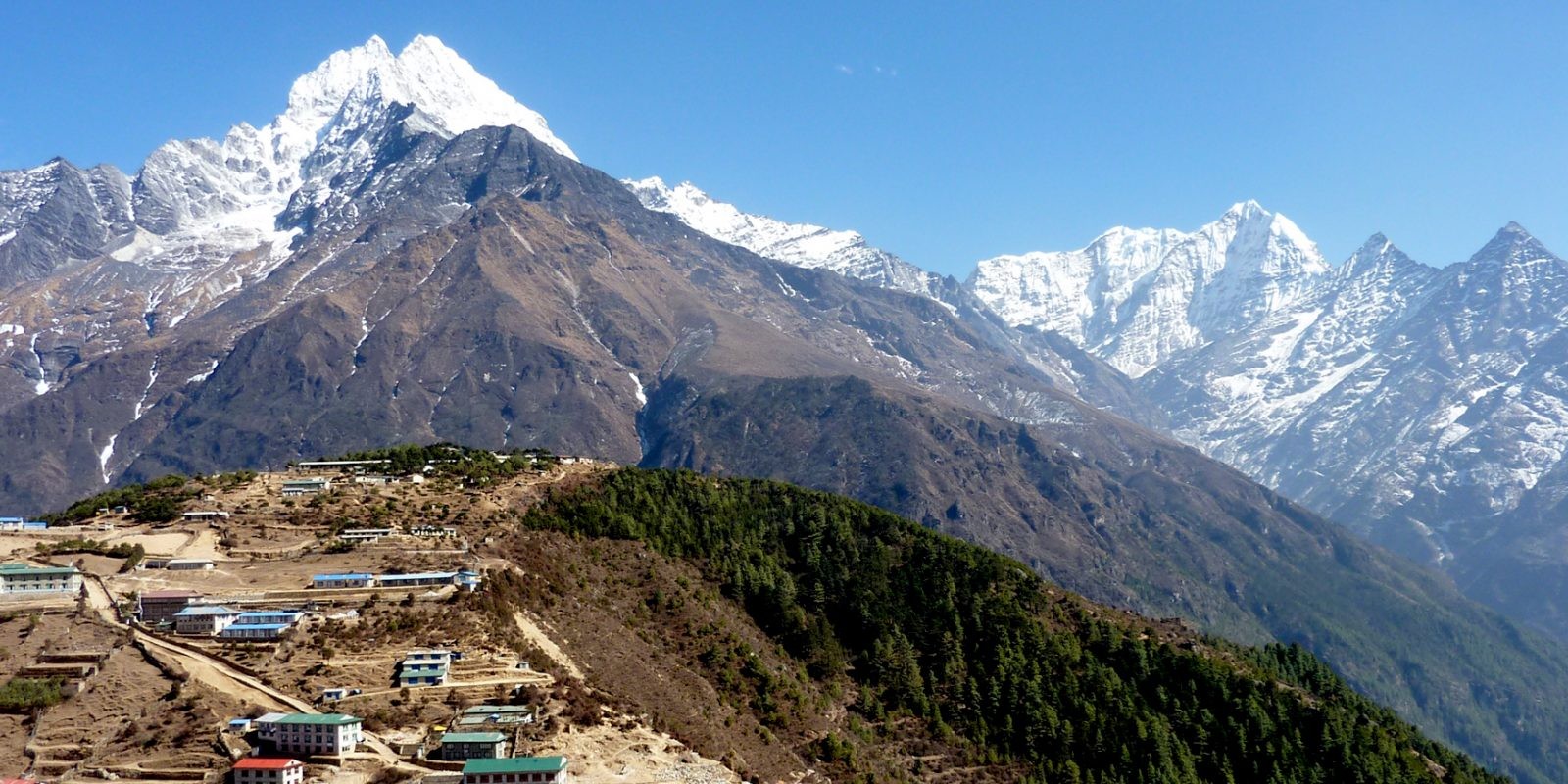Overview
Trekking in lower Dolpo gives tourists an exposure to one of the hidden wilderness in the earth. Dolpo region both the lower and upper is full of Buddhist monasteries and overwhelming for adventure loving trekkers. The lower Dolpo lies in the northwest part of Dolpo region. It is one of the most remote places and is also known for its high mountain Lake Se- Phoksundo. It is located inside the Shey-Phoksundo National Park in mid-western Nepal, behind the Dhaulagiri massif, towards the Tibetan plateau.
Shey Gompa and the rest of the huge park that covers 1,373 sq. km above the sea level, Phoksundo Lake is still restricted. Therefore, requires special trekking permit from Kathmandu to enter both the upper and Lower Dolo region . Lower Dolpo trek offers opportunities to visit ancient villages, high passes, beautiful Lakes, isolated Buddhist monasteries and also to experience the vast array of wildlife inhabiting the region, including Blue sheep, Mountain Goat, Jackal, Wolf and the legendary Snow Leopard. It is still remained one of the isolated corner, even though, for centuries people from Tibetan origin have continued to live, cultivate and do trading with Tibetans. The east and south of it, is bordered by the Dhaulagiri and Churen Himal ranges and to the west by Jumla district. Trekking in Lower Dolpo proffers you the remarkable and worthwhile experience in your lifetime.
Lower Dolpo is considered to be the most popular trek in western Nepal. The trail passes through Shey-Phoksundo National Park for which an entry fee should be paid in addition to the trekking permit fees. The most convenient means of reaching Lower Dolpo is to fly to Juphal airstrip, which is more four-hour walk from Dunai, the district headquarters of Dolpo. There are regular flights to Dunai from Nepalgunj and we, our team of managed its own route that best suit for tourists to make their journey a fondest and memorable in lifetime.
Outline Itinerary
Detailed Itinerary
Day 01: Arrival in Kathmandu (1350m) and hotel transfer
Upon our arrival in Kathmandu, we will picks up you and transfer to hotel. Evening dinner and trip briefing.
Day 02: A day free in Kathmandu/Trip preparations
Today after breakfast you may do some sightseeing in Kathmandu or make the preparation of packing the things for your adventure trip to Dolpo.
Day 03: Fly from Kathmandu to Nepalgunj
We will transfer to Domestic airport in Kathmandu for the flight to Nepaljung. The flight will be about 1 hour. Free in Nepaljungin the afternoon or evening.
Day 04: Fly from Nepalgunj to Jhupal (Dolpo) (2,320m/7,610ft) and trek to Dunai (2,850m/9,348ft) 45 mins flight, 2-3 hours trek
We will take early flight from Nepaljung to Juphal a beautiful town located over the Himalayan foothills, with views of Annapurna and Dhaulagiri peaks to its North. After meeting hit our local staffs we continue walking to Dunai which is the administrative headquarter of the Dolpo region where we have overnight today.
Day 05: Dunai to Tarakot (2,543m/8,341ft) 5-6 hours
After breakfast our trek continues along the southern bank of the Bheri River heading upstream on an easy trail. Along the way, we pass through several deep gorges, hanging bridges and isolated villages. Our trail also includes a tremendous gorge with pine trees and a path built about seven meters above the river. After walking for a while, we will be greeted by the colorful, terraced field of Tarakot, a small village that stands on a hillock to the south of the Bheri River.
Day 06: Tarakot to Laini (3,160 m/10,365 ft)6-7 hours
We walk alongside Tarap Chu river and cross it twice before reaching Sandul Gompa. The gompa lies at a juncture between Barbung Khola and Tarap Chu river. We continue walking on a trail that takes us through farm terraces and rural villages. After ascending and descending for a while, we finally reach Laini for overnight.
Day 07: Laini to Nawarpani (3,545m/11,627 ft)5-6 hours
We climb on a steep trail and walk along switchback above the Tarap River. The walk is quite exciting as the valley becomes a narrow gorge that in some places you can jump from one side to another. Several vigorous climbs and descents will take us to the banks of the Chyugur Khola, from where we reach Nawarpani.
Day 08: Nawarpani to Do Tarap (4,090m/13,415ft) 7-8 hours
We begin today’s trek by gradually ascending to Kamattarka at the confluence of the Tarap Chu and Lang Khola. We cross a narrow gorge and leave the tree line behind us and welcome wild rose and juniper bushes, typical of the dry inner Himalayan valleys. After walking for several more hours, we reach the village of Dho Tarap which is surrounded by an irregular stone wall. In this Valley both Bon Po and Chaiba religious sects reside together. Tarap is also inhabited by a few Tibetans and mostly Magars who have lived here for many generations.
Day 09: Rest Day at Do Tarap for acclimatization
The day off will assist with acclimatization and allow some bodily rest. We can spend the day visiting nearby monasteries. During today’s short walks, we also get a chance to get acquainted with the local culture. The Dolpo people wear homespun clothing that is sometimes dyed a maroon color and they favor Tibetan style somba or dhocha (boots with upturned toes) for foot wear. Both men and women often wear religious amulets and strings of coral, amber and turquoise. The people of the region are both Bon Po and Nyingmapa (Buddhist sects).
Day 10: Trek to Numa La Base Camp (4440m/14,563 ft) 6-7 hours walk
We trek towards the upper Tarap valley enjoying views of lush grasslands on both sides of the river which is unique to this part of the inner Dolpo. We walk alongside Tarap Chu river and take pleasure in the amazing views of the vast Tarap valley with its wide plains and high mountains. A few hours' good walk takes us to the village of Tokyu which houses a Buddhist monastery of the Chiba sect. After exploring the monastery, we continue walking up the valley on a rough trail before reaching the Numa La Base Camp.
Day 11: Cross Numa La pass (5,190m/17,023ft), camp at Pelung Tang (4465m/14,645 ft)6-7 hours
Today is going to be the toughest and one of the longest days of our trek. After breakfast, we begin crossing the Numa La pass on a steep trail all the way up the top ridge of the pass. From the ridge we get incredible views of the barren mountains of Dolpo up to Mt. Dhaulagiri (8167m). After getting to the top of Numa La, we descend to camp at Pelung Tang.
Day 12: Cross Baga La pass (5,070m/16,630ft), trek to Dajok Tang (4,080m/13,382ft)6 hours
After breakfast we begin our steep climb up to the top of Baga La pass. From here, we get fantastic views of the dry landscape and the distant snow-capped mountains including Mt. Kanjirowa. We spend some time at the top of the pass taking pictures and generally enjoying the mesmerizing views. Next, we descend to Dajok Tang for overnight.
Day 13: Dajok Tang to Ringmo (3,600m/11,808ft)3-4 hours
We spend most of today’s trek on trails alongside beautiful pine forests and alpine vegetation. After trekking for a short while on an easy trail with only gradual highs and lows, we reach Ringmo Village. The village is a traditional Tibetan village of the Dolpo region. Overnight in Ringmo.
Day 14: Hike to Phoksundo Lake
Today we explore the great Phoksundo Lake and camp at its shores. We see yak caravans moving in and out of Ringmo mostly towards Tibetan borders on remote mountain trails. The scene is even depicted in a Hollywood movie ‘Caravan’ shot mostly in this location. On our way to the lake, we also tour a nearby monastery. Upon reaching the Phoksundo Lake, we can enjoy a relaxing walk on the serene lake’s shores. Overnight at Phoksundo.
Day 15: Phoksundo Lake to Shyanta (2520m/8265 ft)5-6 hours walk
We trek downhill to Chepka. From Chepka the trail follows a massive overhanging rock. During our trek, we find many important medicinal minerals which are believed to cure almost anything in this area. The route then passes through villages, before climbing to Shyanta for overnight.
Day 16: Shyanta to Jhupal
We march towards Jhupal via Sulighat on a trail surrounded by birch trees. After reaching Jhupal, we can spend our afternoon exploring the busy market take rest.
Day 17: Fly to Nepalgunj and Kathmandu
We take the earlyflight from Jhupal to Nepalgunj and connecting flight to Kathmandu. Arrival pick up at Kathmandu airport and hotel transfer.
Day 18: Final departure from Kathmandu
Free till deaprture.Our representative will drop to Kathmandu airport.
Cost Details
- Nepal visa fee
- International airfare to/from Kathmandu.
- Alcoholic beverages, bottle mineral water, soft drinks and snack foods
- Any personal medical or evacuation expenses
- Riding horse along the trek
- Extra cost on natural disaster and unforseen circumistances
- Any personal expenses
- Extra night hotel Nepalgunj due to bad weather and earlier back to Kathmandu
- Helicopter charter and all accommodation on flight cancellation due to bad weather
- Tips to trekking crews
Equipments Checklist
Clothing
Warm jacket or down jacket
Water and windproof jacket, poncho or umbrella
Long sleeved synthetic fleece
Thermal underwear
Hat, pair of gloves and scarf
Comfortable hiking trousers (loose fitting)
Shorts and trousers, or skirt
2 pairs of warm wool-blend socks
2 pairs of running socks or liner socks
Proper hiking boots
Running shoes and flip-flops
T-shirts
During winter season, additional clothings may include:
The outer jacket should be warm, down jacket is highly recommended during winter season
Bring a pair of warm winter trousers, in addition to the hiking trousers
Bring at least one windproof layer of clothes, helping to reduce any chill factor influence.
Snow gaitors
Trekking Gear
Pair of polarizing sun-glasses (to be comfortable and to avoid potential snow-blindness)
Backpack and backpack cover (against rain and dust)
Map of the trekking area
Head torch, or small torch, plus spare batteries
Sleeping bag and silk liner
Water bottles
Miscellaneous
Toiletries
A small light weight and quick drying towel
Bar of soap
Sunscreen (at least SPF +20)
Earplugs
Insect repellants (for lower elevations)
First aid kid
Water purification tables or a water filter
Some Diamox pills against potential altitude sickness (if going beyond 4,000 m elevations)
Toilet paper
Optional items
Camera, battery etc
Altimeter
Compass
Binoculars
Books/magazines
Trekking poles
GPS unit
Padlocks for guest house rooms and bags
Sewing/repair kit
Pocket knife
Candles (for lodges)
Dairy or notebook plus pencil/pen
Camping
Tent
Stove and fuel
Cooking, eating and drinking utensils
Sleeping mat
Food and water (for the very remote trekking areas)



